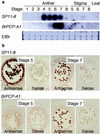The pollen determinant of self-incompatibility in Brassica campestris
- PMID: 10677556
- PMCID: PMC26537
- DOI: 10.1073/pnas.040556397
The pollen determinant of self-incompatibility in Brassica campestris
Abstract
Many flowering plants possess self-incompatibility (SI) systems that prevent inbreeding. In Brassica, SI is controlled by a single polymorphic locus, the S locus. Two highly polymorphic S locus genes, SLG (S locus glycoprotein) and SRK (S receptor kinase), have been identified, both of which are expressed predominantly in the stigmatic papillar cell. We have shown recently that SRK is the determinant of the S haplotype specificity of the stigma. SRK is thought to serve as a receptor for a pollen ligand, which presumably is encoded by another polymorphic gene at the S locus. We previously have identified an S locus gene, SP11 (S locus protein 11), of the S(9) haplotype of Brassica campestris and proposed that it potentially encodes the pollen ligand. SP11 is a novel member of the PCP (pollen coat protein) family of proteins, some members of which have been shown to interact with SLG. In this work, we identified the SP11 gene from three additional S haplotypes and further characterized the gene. We found that (i) SP11 showed an S haplotype-specific sequence polymorphism; (ii) SP11 was located in the immediate flanking region of the SRK gene of the four S haplotypes examined; (iii) SP11 was expressed in the tapetum of the anther, a site consistent with sporophytic control of Brassica SI; and (iv) recombinant SP11 of the S(9) haplotype applied to papillar cells of S(9) stigmas, but not of S(8) stigmas, elicited SI response, resulting in inhibition of hydration of cross-pollen. All these results taken together strongly suggest that SP11 is the pollen S determinant in SI.
Figures




References
-
- Bateman A J. Heredity. 1955;9:53–68.
-
- Nou I S, Watanabe M, Isogai A, Hinata K. Sex Plant Reprod. 1993;6:79–86.
-
- Nasrallah J B, Kao T-H, Goldberg M L, Nasrallah M E. Nature (London) 1985;318:263–267.
-
- Takayama S, Isogai A, Tsukamoto C, Ueda Y, Hinata K, Okazaki K, Suzuki A. Nature (London) 1987;326:102–104.
Publication types
MeSH terms
Substances
Associated data
- Actions
- Actions
- Actions
- Actions
LinkOut - more resources
Full Text Sources
Other Literature Sources
Research Materials

